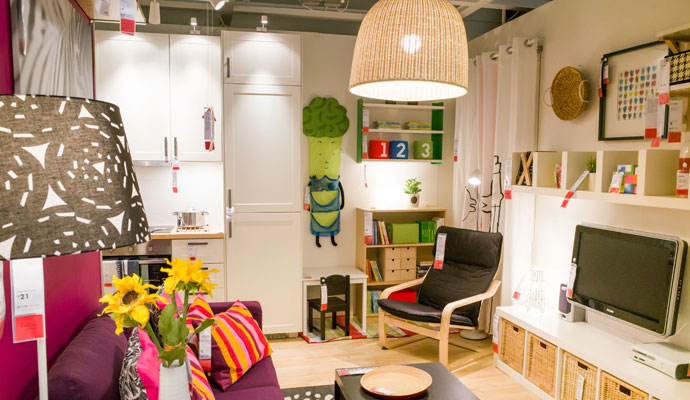The legacy of IKEA founder Ingvar Kamprad
He understood that everything a company sells — and everything its customers do — should contribute to the experience.
IKEA's founder, Ingvar Kamprad, who died January 27 at the age of 91, leaves behind a legacy that extends beyond his business. His business in itself would be enough: a global chain of some 379 stores that sells upward of US$40 billion a year in low-cost domestic furnishings and dominates the household furniture category worldwide. From the company’s beginning, in 1943, observers of IKEA have remarked on the elegant Scandinavian design and consistently low cost of its exotically named furniture, but the heart of Kamprad’s genius — and of his influence — was the design of IKEA’s customer experience and imbuing it with empathy.
Before Jeff Bezos made shopping about the ease of one-click purchasing, Ingvad Kamprad made shopping about the excitement of going to the store. Visiting an IKEA outlet was an adventure, not a chore. It had to be; to save cost, the stores were located far from the city center, and customers needed an incentive to make the trek. IKEA stores displayed furniture in simulated rooms that allowed customers to imagine their new living quarters. In-store cafes sold Swedish meatballs to shore up the peckish, lengthen visits, and provide a place for shoppers — usually couples — to discuss and decide on their purchases. And customers could carry away their wares that day rather than rely on vague promises of future delivery. Sure, there would be “some assembly required,” but that was a feature, not a bug. It made people feel like the furniture was truly their own.
IKEA tapped into customers’ emotions in other ways as well. It gave newlyweds and fledgling families pride of ownership and agency, freeing them from living with someone else’s mismatched castoffs. The Scandinavian design was unfussy, contemporary, and fresh — like the customer. It was also affordable, and durable enough that people had time to save up for replacements.
When it added free onsite childcare and cafeterias serving comfort food, IKEA solved two common problems for shoppers, displaying a level of empathy that was as practical as it was revolutionary. Getting lost in its massive stores (average size today: 300,000 square feet), schlepping boxes from the store to the car, and dealing with the challenges of assembly have become humorous tropes in contemporary entertainment. But IKEA’s combination of style and DIY works, to the consternation of IKEA’s rivals.
Before Jeff Bezos made shopping about the ease of one-click purchasing, Ingvar Kamprad made shopping about the excitement of going to the store.
One puzzled rival remarked to us, “I don’t know why their customers put up with having to do the work.” The answer to that question is explored in a study called “The IKEA Effect: When Labor Leads to Love” (pdf), by professors Michael Norton (Harvard), Daniel Mochon (Tulane), and Dan Ariely (Duke). IKEA’s customers might be novices with an Allen wrench, but they don’t subtract their notional labor cost from the value they put on the products they buy. Paradoxically, they add it, proud that they saved money, proud that they did the work, and proud that it looks good. (As the company’s slogan puts it, “You do your part. We do our part. Together, we save money.”)
All these elements come together to forge another part of IKEA’s success: its ruthless dedication to setting and meeting customer expectations. It doesn’t promise luxury, but it does promise style, practicality, value, and adventure — and delivers on those promises. Is it possible to separate the value of IKEA’s furniture from the value of its customer experience? We would argue no, because the brand is built on the experience and the emotions stirred up by it and the products themselves.
Indeed, although its stores are iconic, IKEA has mastered the art of creating an IKEA experience in every channel. Its web pages and print catalogs echo the stores. Websites offer “Click and Collect” locations where customers can pick up what they’ve ordered. Shoppers can even take the meatballs home — pre-assembled and frozen.
You see Kamprad’s influence in many other retail outlets. It’s in grocery stores that offer childcare; in Costco’s and Home Depot’s warehouse-size stores; and in home furnishing retailer Restoration Hardware’s room vignettes curated for the “Buenos Aries Villa” or the “Antwerp Canal House.” And you see it in, well, if not meatballs, then pepperoni: In 2016, Urban Outfitters, owner of the apparel brands Anthropologie and Free People, among others, bought the upscale Pizzeria Vetri chain and opened an outpost adjacent to those three retail shops in the giant King of Prussia mall outside Philadelphia. The dining/shopping experiment was so successful the company is rolling out the same concept elsewhere.
Some might argue that IKEA has evolved over the years from its bare-bones, no-frills, lug-it-away-today roots. Assembly or installation — for a fee — can be arranged by IKEA, which contracts with third-party services. Last year, IKEA purchased TaskRabbit, a company that matches the not-so-handy with handymen, a recognition that DIY isn’t for everyone. And the company is experimenting in some markets with smaller stores that are both high tech and high touch, with virtual reality and a surfeit of staff ready, willing, and able to assist.
But these evolutions aren’t a sign of weakness in IKEA’s core business model. Rather, they are variations on the same fundamental, classic IKEA experience, which is built on the twin foundations of empathy and emotion. If today’s — or tomorrow’s — customers can better envision themselves in a Nordli bedroom via a computer simulation than via a trip to the mall, that’s where IKEA will meet them. The essence of the IKEA experience remains what Kamprad designed: an immersive environment that allows young shoppers not only to imagine their new home but to have a hand in creating it. And it continues to pay off: IKEA’s same-store sales increased 4.8 percent in the year that ended last August. As retailers struggle to make sense of an increasingly digital world that is about both fragmentation and consolidation, they could do worse than study IKEA’s playbook.




